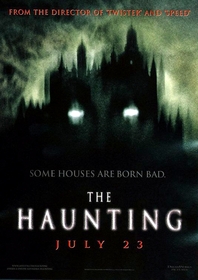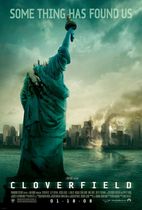Our editor-in-chief Nate Yapp is proud to have contributed to the new book Hidden Horror: A Celebration of 101 Underrated and Overlooked Fright Flicks, edited by Aaron Christensen. Another contributors include Anthony Timpone, B.J. Colangelo, Dave Alexander, Classic-Horror.com's own Robert C. Ring and John W. Bowen. Pick up a copy today from Amazon.com!
The Haunting (1999)
The conventional wisdom among the self-appointed horror literati is that compared to the 1963 Robert Wise film of the same name, the 1999 Jan de Bont remake of The Haunting amounts to so much computer effects garbage. As might not surprise anyone familiar with my reviews, I have a perverse, natural tendency to disagree with the self-appointed literati--blame it on whatever you’d like. In my opinion, the 1999 film blows the 1963 one out of the water from just about every possible aspect we can examine.
Here’s the obligatory synopsis for anyone not familiar with the Wise film or the overrated Shirley Jackson novel that served as the source material. Dr. David Morrow (Liam Neeson) is a psychology professor. His main research interests are fear and mass hysteria. He sets up a faux experiment for insomniacs at Hill House, which he chooses because it is enigmatic, surreal, and the perfect setting for planting psychological catalysts in suggestible minds. His real goal is to see how far his carefully crafted suggestions will go in making his subjects (and for some odd reason there are only three -- Eleanor {Lili Taylor}, Theodora {Catherine Zeta-Jones} and Luke {Owen Wilson}) think they’re experiencing supernatural phenomena. I admit that there may be some minor plausibility problems in the premise, but that’s not the fault of either de Bont or Wise, but Jackson’s book. In any event, it’s horror, which is a fantasy subgenre, so plausibility problems shouldn’t be any more marring than the same in a fairy tale.
The most unusual and persistent myth about the 1999 The Haunting is that everything is overblown and not left to your imagination, and that’s contrasted with the Wise film. I’m not calling it a myth just because I really happen to like this film, and yes, de Bont shows much more on screen with the aid of various mechanical and computer effects, but he also retains all of the subtle elements of the Wise film. Taylor recreates the psychological torment of Eleanor, and this time without the irritating voice-overs, the complex suggested relationships of the main characters are intact, the weird sounds and flexing walls with unseen sources are still here, etc.
I can’t help but feel that there is simply a contingent of horror-fan luddites who automatically dismiss any film that uses computer-assisted effects rather than quick cuts, ketchup and chocolate syrup. If you’re one of those "fans", then by all means avoid The Haunting, because as soon as you see a computer-animated ghost working its way along the curtains, you’re going to feel an urge to hurl your television set out the window. Some of us don’t champion political boycotts of certain techniques and technology, and we don’t mind directors blatantly showing us something wild and surreal -- in fact we enjoy indulging in other’s fantasies. For us, The Haunting will be extremely rewarding.
If you’re at all interested in the craft of filmmaking, The Haunting is a must see for the set design if not for anything else. You could spend hours letting your eyes get lost in any given set, and there are tens of them throughout the film. Unlike the Wise film, de Bont comes much closer to realizing the house with no right angles that Jackson mentions in the book. De Bont’s Hill House is creepy, disorienting, and sublimely beautiful. It really is a "fifth character" as everyone involved with the film likes to point out, and greatly adds to the spooky atmosphere of the film.
For my money, de Bont’s film tells the story much better than either of the previous attempts, and it cuts out almost all of the grating, pointless, non-horror elements like "cups of stars" and "a house with lions in front". This is a classic haunted house film, full of jolts, shocks, suggestions, mildly graphic elements, and heavy atmosphere. It offers the best of a wide swath of horror styles, and integrates them with fine performances, an excellent score, and some of the best visuals in recent years, resulting in a film that gradually increases in emotional intensity. Traditionalist stiffs should look elsewhere. Everyone else shouldn’t miss this one.









The original Haunting bored
The original Haunting bored the living snot out of me. But I honestly would rather watch that again than this over-dramatic, shrill, whiny, CGI-heavy, awful lame remake.
I'm glad you stuck to your
I'm glad you stuck to your guns, it made this review much more interesting. I also thought the CGI really reinforced the otherworldliness of the house. As you suggest, the premise of why they're there is the only weak link, but once accepted the rest of the plot follows logically. I've seen this version 3 or 4 times, and still find it an enjoyable romp.
The CGI didn't bother me and
The CGI didn't bother me and I thought the acting was pretty good...but this is still a terrible film. The main problem is that it just isn't scary. I kept looking at my watch patiently waiting for it to end. On the other hand the original scared me silly. They don't show anything and it works beautifully. NO special effects can duplicate what you're thinking just hearing the sounds in the original. The remake over explains everything to death and I didn't find the ghosts scary or interesting. Sure--the special effects are great but I was bored beyond belief. I'm glad you enjoyed it but I certainly didn't!
Interesting review,
Interesting review, thanks.
I've got both versions on DVD and like both. The question is: If I could only ever watch one again would it be the 1999 or 1963 version? On balance it'd be the 1963 one. I've always been a fan of understated psychological supernatural horror, and I couldn't face never again seeing the scene in The Haunting (1963) where the sound of sobbing and subtle changes in lighting turn carved wood-work into faces. That scene is one of the most effective movie moments in supernatural horror.